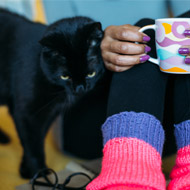
Study dispels misconception that cats are aloof
A study by US researchers has revealed that cats prefer human interaction more than food or toys.
Writing in the journal Behavioural Processes, researchers from Oregon State University describe a ‘free-operant preference assessment’ they conducted with shelter and pet cats.
In the study, researchers left the cats in a room with various stimuli and observed how much interest they showed in each one. The preference assessment categories included social interaction, food, toys and scent.
“Although there was clear individual variability in cat preference, social interaction with humans was the most-preferred stimulus category for the majority of cats, followed by food,” the researchers said. “This was true for cats in both the pet and shelter population.”
It is a common belief - particular among those that dislike cats - that most felines are aloof, stubborn and difficult to train. Keen to dispel this misconception, lead researcher Kristyn Vitale Shreve decided to assess whether this was true.
Kristyn’s team placed a total of 55 cats - 22 from animal shelters and 23 pets - in solitary confinement for two and a half hours. They used this time to work out each cat's preferred item of food (cat treats, chicken or tuna), toy (fuzzy mouse, feather, or toy on a springy wire), scent (catnip, gerbil or other cat - presented on a cloth) and human interaction (petting, baby talk or playing with a feather toy).
The cats were then surrounded by their preferred stimuli to see how much they interacted with them. While not every cat grasped the experiment, 19 of the cats spent most of their time with interacting with the human, rather than the food, toy or scent.
The food was the second most preferred item, enjoyed by 14 of the cats. Four cats opted for the toys and one went for the scent.
Looking ahead, the researchers hope to build on their findings by examining the use of the preferred stimuli as enrichment in applied settings. They also aim to assess individual cat’s motivation to work for their most-preferred stimulus as a measure of reinforcement.



 FIVP has shared a survey, inviting those working in independent practice to share their views on the CMA's proposed remedies.
FIVP has shared a survey, inviting those working in independent practice to share their views on the CMA's proposed remedies.